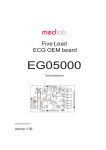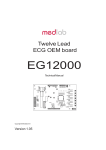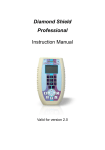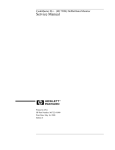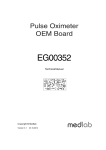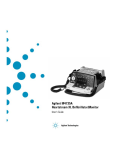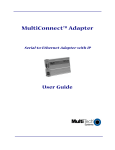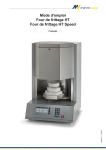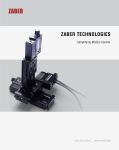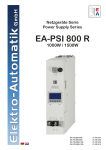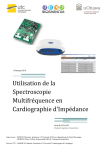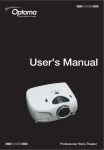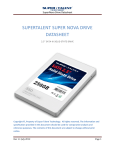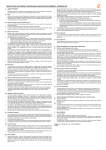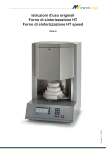Download Technical Manual
Transcript
Medlab GmbH Three Lead ECG OEM Module EG01010 User Manual medlab Three Lead ECG OEM board EG01010 Technical Manual Copyright © Medlab 2008 - 2013 Version 1.02 1 Version 1.02 22.04.2013 Medlab GmbH Three Lead ECG OEM Module EG01010 User Manual Medlab GmbH [email protected] www.medlab-gmbh.de Version 1.02 22.04.2013 2 Medlab GmbH Three Lead ECG OEM Module EG01010 User Manual Table of Contents Mechanical Dimensions 4 Overview 4 Description of the Module and Connectors 5 Physical Units of Transmitted Data 5 Specifications 6 Connector Assignment 7 Compliance with IEC60601-2-27 8 Software Protocol Description 10 Serial Transmission 10 Serial Transmission Protocol 11 Commands accepted by the Module 12 PC Test Program 14 Regulatory Considerations 15 Document Revisions 15 3 Version 1.02 22.04.2013 Medlab GmbH Three Lead ECG OEM Module EG01010 User Manual Mechanical Dimensions of the Module $OO 'LPHQVLRQV LQ PP Mechanical drawing, top view of the module (1:1) Overview The scope of this document is the description and specification of Medlab's three lead ECG board EG01010. It should help anybody who is familiar with both programming and basic electronics to select the proper hardware and software version for his application as well as to help him integrate the board into his own electronic system. The EG01010 measures one of three channels of ECG using a three lead cable. The isolated patient ground must not be connected to the mains ground. The EG01010 has full patient isolation on the board, that means that the input voltage of 5 volts has no galvanic contact to the patient. Furthermore, the module is defibrillation protected. The isolation gap can be easily seen on the board: it is the area that is bridged only by the transformer 76250 and the couplers ADUM2402. No connections to anything except the patient cable must be made on the patient cable input side of the module (see drawing on the next page). With a three lead cable, the module can output the following channels: I or II or III. The isolated ground of the module is switched to the unused electrode in the respective setting, e.g. isolated ground is on the left leg electrode if the module is set to channel I, left hand electrode if module is set to channel II and right hand electrode if channel III is selected. Only one curve at a time can be measured, e.g. Einthoven I or II or III. Version 1.02 22.04.2013 4 Medlab GmbH Three Lead ECG OEM Module EG01010 User Manual Description of the Module and Connectors 0RXQWLQJ +ROHV &RQQHFWRU 5HVSLUDWLRQ %RDUG 3DWLHQW &DEOH &RQQHFWRU +RVW 3RZHU &RQQHFWRU 3DWLHQW ,VRODWLRQ &RQQHFWRU 5HVSLUDWLRQ %RDUG Description of connectors and areas of the module (1:1) Physical Units of Transmitted Data Scaling of ECGs is done normally in the unit "cm/mV" for the Y-axis and in "mm/sec" for the X-axis. Respiration rate is transmitted in „rpm“ (respirations per minute). Pulse rate is transmitted in „bpm“ (beats per minute). Transmission speed for the wave is indicated in Hz (sec-1). ECG amplitudes are normally indicated in „cm/mV“. Since this is depending directly on the resolution of the screen the user is working with, the transmitted samples are not directly scaled in this unit, but fall into the range of 0-0xF7 (8 Bit samples, 0xF8 to 0xFF reserved for commands). It is within the responsibility of the user to scale the transmitted samples in a way that the waves displayed onto his screen fit to the usual scales used in medicine, 0.5, 1, 2 and 4 cm/mV. The amplification of the module in the different amplification stages is: Stage 1 Stage 2 Stage 3 1mv = 32 1mV = 64 1mV = 128 Normal values for the trace speed are 12.5 mm/sec, 25 mm/sec and 50 mm/sec. 5 Version 1.02 22.04.2013 Medlab GmbH Three Lead ECG OEM Module EG01010 User Manual Technical Data (Specifications) Mechanical data: 88 mm x 53 mm see page 4 for board drawing 4 layer PCB, thickness 1.5 mm Maximum height: With respiration option: 12 mm 25 mm Attachment: four M2.5 screws in the corners of the PCB Weight: 32 g Operating voltage: 5 Volt, +/- 10 %, 45 mA Power consumption: 225 mW while measuring Input: Patient Isolation: Defibrillation protected CF, 4000 Volts RMS Amplification: Data transmission: Filtering: Three levels, user selectable Three frequencies, user selectable Integrated 50 Hz or 60 Hz notch filter Amplifier frequency range: 0.05 to 70 Hz. Pulse detection: Respiration detection: 30 .. 248 bpm +/- 1%, +/- 1 Digit, 8 beat average 5 .. 99 rpm +/-3%, +- 1 Digit, 8 samples average (option) Output: Asynchronous serial output with CMOS levels (0...5 V) Hardware pulse trigger output, CMOS levels (0...5 V) Both outputs fully isolated from patient Protocol: Standard bidirectional serial protocol, see description on following pages Connector: Connectors compatible to Medlab EG05000 five channel OEM board Optional connectors for Medlab 00731 respiration board Version 1.02 22.04.2013 6 Medlab GmbH Three Lead ECG OEM Module EG01010 User Manual Connectors (see attached drawing for location) Header for host connection: JP1: 1 2 3 4 5 6 7 8 9 10 11 12 13 14 15 16 Ground Ground Txd (RS232 level +/- 5Volt) Txd (TTL level) Rxd (RS232 level +/- 5Volt) Rxd (TTL level) Not connected Not connected Not connected Not connected Pulse Trigger output Pulse Trigger output Shutdown (VCC level on this pin powers down module) Shutdown (VCC level on this pin powers down module) VCC input VCC input Note: The pulse trigger is a high active, rectangular signal with a pulse width of 33 ms. Delay to the R wave can be adjusted by a command. Header for patient cable connection SV1: 1 2 3 4 5 6 7 Unused SHIELD LL-IN RA-IN LA-IN SHIELD Unused 7KUHH /HDG 3DWLHQW &DEOH 6KLHOG 6KLHOG /HIW $UP 5LJKW $UP /HIW /HJ 6KLHOG , RU ,, RU ,,, )LYH /HDG 3DWLHQW &DEOH )RXU /HDG 3DWLHQW &DEOH It is very important to connect the black clamp to the left leg or hip, not to the right leg or hip of the patient. If you connect it to the wrong leg, there is one channel that shows no ECG at all, the II channel, because the board tries to sense the voltage between right arm and right leg in this case. 5LJKW /HJ 6KLHOG /HIW $UP 5LJKW $UP 6KLHOG , DQG ,, DQG ,,, DQG D9/ DQG D95 DQG D9) /HIW /HJ 6KLHOG 5LJKW /HJ /HIW $UP 5LJKW $UP /HIW /HJ &KHVW , DQG ,, DQG ,,, DQG D9/ DQG D95 DQG D9) DQG & ECG cable connection Remark: For respiration measurement (optional respiration board needed), electrodes should be attached to chest and hip, not arm and leg. 7 Version 1.02 22.04.2013 Medlab GmbH Three Lead ECG OEM Module EG01010 User Manual Technical Description for TRF IEC 60601-2-27 When preparing a test report form (TRF) for proof of compliance of the user's medical product to IEC60601-2-27:2005, the following remarks / technical data will be helpful or needed: Input Impedance: Common mode rejection ratio: Input Dynamic Range: Defibrillator Discharge Recovery: Leads-off sensing current: > 10 MOhm > 90 dB at 50 Hz or 60 Hz ±5 mV AC, ±300 mV DC <10 sec per IEC 601-2-27 <10 sec per AAMI EC13-1992 Applied currents less than 150 nA The following information references particular sections of IEC 601-2-27 Respiration (optional) Section 6.8.2.bb.1) Applied currents less than 80 µA @ 90 kHz square Tall T-wave rejection. Section 6.8.2.bb.2) T-wave of 1.2 mV amplitude will not affect heart rate determination. Heart rate averaging. Section 6.8.2.bb.3) TBD Response to irregular rhythm. Section 6.8.2.bb.4) A1) Ventricular bigeminy: the EG01010 counts both large and small QRS complexes to display a rate of 80 bpm. A2) Slow alternating ventricular bigeminy: the EG01010 counts both large and small QRS complexes to display a rate of 60 bpm. A3) Rapid alternating ventricular bigeminy: the EG01010 counts all QRS complexes to display a rate of 120 bpm. A4) Bi-directional systoles: the EG01010 counts all QRS complexes to display a rate of 90 bpm. Heart rate meter response time. Section 6.8.2.bb.5) a) Change from 80 to 120 BPM: 4 sec b) Change from 80 to 40 BPM: 7 sec Time to alarm for tachycardia. Section 6.8.2.bb.6) Waveform B1: Amplitude 0,5 mV 1 mV 2 mV Waveform B2 Amplitude 1 mV 2 mV 4 mV Time to alarm 1 sec 1 sec 1 sec Time to alarm 1 sec 1 sec 1 sec Pacemaker pulse display capability (See IEC 601-2-27 clause 50.102.12) The EG01010 is capable of displaying the ECG signal in the presence of pacemaker pulses with amplitudes of ±2 mV to ±700 mV and durations of 0.1 ms to 2.0 ms. An indication for the pacemaker pulse is provided. Version 1.02 22.04.2013 8 Medlab GmbH Three Lead ECG OEM Module EG01010 User Manual Pacemaker pulse rejection (See IEC 601-2-27 clause 50.102.13) Without over/undershoot: a) For single (ventricular-only) pacemaker pulses alone, with 0.1 and 2.0 ms pulse-widths and ±2 mV and ± 700 mV pulse-amplitudes, the EG01010 correctly displays heart rate as zero bpm (Asystole). b) For single (ventricular-only) pacemaker pulses with normally paced QRS-T, with 0.1 and 2.0 ms pulse-widths and ±2 mV and ± 700 mV pulse-amplitudes, the EG01010 correctly displays heart rate of the QRS-T rhythm (60 bpm for the specified test waveform). c) For single (ventricular-only) pacemaker pulses with ineffectively paced QRS pattern, with 0.1 and 2.0 ms pulse-widths and ±2 mV and ± 700 mV pulse-amplitudes, the EG01010 correctly displays heart rate of the underlying QRS-T rhythm (30 bpm). d) For atrial/ventricular pacemaker pulses alone, with 0.1 and 2.0 ms pulse-widths and ±2 mV and ± 700 mV pulse-amplitudes, the EG01010 correctly displays heart rate of zero bpm (Asystole). e) For atrial/ventricular pacemaker pulses with normally paced QRS-T, with 0.1 and 2.0 ms pulsewidths and ±2 mV and ± 700 mV pulse-amplitudes, the EG01010 correctly displays heart rate of the QRS-T rhythm (60 bpm). f) For atrial/ventricular pacemaker pulses with ineffectively paced QRS pattern, with 0.1 and 2.0 ms pulse-widths and ±2 mV and ± 700 mV pulse-amplitudes, the EG01010 correctly displays heart rate of the underlying QRS-T rhythm (30 bpm). With over/undershoot: a) For single (ventricular-only) pacemaker pulses alone, with 0.1 and 2.0 ms pulse-widths and ±2 mV and ± 700 mV pulse-amplitudes, the EG01010 correctly displays heart rate of zero bpm (Asystole). b) For single (ventricular-only) pacemaker pulses with normally paced QRS-T, with 0.1 and 2.0 ms pulse-widths and ±2 mV and ± 700 mV pulse-amplitudes, the EG01010 correctly displays heart rate of the QRS-T rhythm (60 bpm). c) For single (ventricular-only) pacemaker pulses with ineffectively paced QRS pattern, with 0.1 and 2.0 ms pulse-widths and ±2 mV and ± 700 mV pulse-amplitudes, the EG01010 correctly displays heart rate of the underlying QRS-T rhythm (30 bpm). d) For atrial/ventricular pacemaker pulses alone, with 0.1 and 2.0 ms pulse-widths and ±2 mV and ± 700 mV pulse-amplitudes, the EG01010 correctly displays heart rate of zero bpm (Asystole). 9 Version 1.02 22.04.2013 Medlab GmbH Three Lead ECG OEM Module EG01010 User Manual Serial Transmission The normal connection to the board is done via serial, asynchronous communication at 9600 baud, 8 data bits, no parity bit and one stop bit. Both CMOS and RS232 (+/- 5 Volt level) voltage levels are available. This protocol is token oriented. Special marker bytes that are not present in the normal data stream mark the meaning of the following byte. The RS232 voltage levels are helpful during evaluation of the board, which can be done using an ordinary PC and a special software. The connection in the customer’s final system could be done through 0V/5V levels, which saves parts on the customer’s side of the data stream. Connector JP1 is compatible with the interface connector on Medlab’s EG05000 five channel ECG OEM board. Therefore, test cables that have been built for this board can also be used for the EG01010 board. The EG01010 sends a continuous data stream and receives commands. Commands are one byte characters, some of them have an additional parameter, others just toggle an internal switch in the EG01010 module. The neutral line of the ECG always lies at 128, the module transmits unsigned byte data. While a lead off condition is active, a pulse value of 0 and a neutral line of 128 is transmitted. The module powers up with amplification set to level 0 and speed set to level 1, which means lowest amplification stage and transmission of 100 sample points per second. Simulation mode is off at power up, the notch filter is set to 50 Hz and monitoring mode is selected. For details, please see the protocol description on the following pages. Version 1.02 22.04.2013 10 Medlab GmbH Three Lead ECG OEM Module EG01010 User Manual Serial Transmission Protocol All data is transmitted at 9600 baud, 8 bits, 1 stop bit, no parity. Each time a pulse is detected by the board's internal algorithm, a block with a new, averaged pulse rate is transmitted. The pulse detector is of high quality, and the point in time where the pulse marker (0xFA) is transmitted can be used for triggering applications that require to synchronize other devices to a patient's R-wave. The ECG wave sample points are transmitted continuously with 50, 100 or 300 bytes per second, according to the user's last command. The curve sample points lie between 0 and 246, with the neutral line of the ECG being at 128. Values that are higher than 246 (0xF6) are used for marking the following byte as a new data values according to the following definition: Marker byte Meaning of following byte(s) 0xF8 wave sample points follow 0xF9 Respiration rate follows (optional respiration board needs to be present) 0xFA Pulse value follows 0xFB Info byte follows 0x11 The only info byte defined is 0x11, "LEAD OFF" Others may be added in the future Commands accepted by the module "N" "M" "S" "0" "S" "1" "S" "2" "A" "0" "A" "1" "A" "2" "G" "0" "G" "1" "G" "2" "D" "0" "D" "1" "5" "6" "C" "T" "0" "T" "1" "T" "2" "T" "9" "P" "0" "P" "1" normal operation mode switch to simulation mode send ECG trace with 300 Hz send ECG trace with 100 Hz send ECG trace with 50 Hz amplification stage 0 amplification stage 1 amplification stage 2 channel III channel II channel I show ECG curve show respiration curve turn on 50 Hz notch filter turn on 60 Hz notch filter calibrate, send 1mV pulse Pulse trigger 15 ms after R Pulse trigger 50 ms after R Pulse trigger 100 ms after R Pulse trigger middle between R Pacemaker detection off Pacemaker detection on Example transmitted data stream : Wave Marker Wave Sampl es Pul se 120 Wave Marker Wave Sampl es 0xF8 0x20 0x23 0x25 0xFA 0x78 0xF8 0x25 0x25 0x26 ○ ○ ○ ○ ○ ○ ○ ○ ○ ○ ○ ○ ○ ○ ○ ○ ○ ○ ○ ○ ○ ○ ○ ○ ○ ○○ ○ ○ ○ Time 11 Version 1.02 22.04.2013 Medlab GmbH Three Lead ECG OEM Module EG01010 User Manual Commands accepted by the Module All commands have a one or two byte structure. They are also sent to the module with 9600 baud. The commands are sent in ASCII format. Basic Bandwidth of ECG amplifier (Diagnostic or Monitoring mode): „F“ Parameter: "0" or "1" „0“ bandwidth of the amplifier DC-80 Hz Diagnostic mode (bear in mind mains filter setting) „1“ bandwidth of the amplifier 0.67-40 Hz Monitoring mode (reset value) „S“ extra strong filter, lower edge frequency 2 Hz Transmission frequency of the waveform packet: „S“ Parameter: "0", "1", "2" (0x53 0x31 for example for „S1“) „0“ send waveform packets 300 times per second „1“ send waveform packets 100 times per second „2“ send waveform packets 50 times per second (reset value) Amplification of the waveforms „A“ Parameter: "0“, "1“, "2" or "3" (0x41 0x31 for example for „A1“) „0“ Amplification stage 1 (lowest amplification, should be scaled to 0.5 cm/mV) „1“ Amplification stage 2 „2“ Amplification stage 3 (highest amplification, should be scaled to 2 cm/mV) Each amplification stage has double the sensitivity of the previous stage Channel selection (1 wave channel can be selected) „G“ Parameter: "0", "1" or "2" (for Einthoven III, II or I selection) Filtering of the waveforms for 50 and 60 Hz line frequency: „5“ 50Hz Filter on „6“ 60 Hz Filter on Selecting the transmitted waveform: „D“ Parameter: „0“ or „1“ (0x44 0x30 for example for „D0“) „0“ Show ECG trace (reset value) „1“ Show respiration waveform (optional respiration board needed) Calibration mode (1mV rectangle transmitted for 250 samples): „C“ output 250 samples of 1 mV rectangular waves, then go back to normal mode Simulated data outputs (useful for testing or exhibitions): „M“ use simulated output waves and values „N“ use real input for data transmission Version 1.02 22.04.2013 (reset value) 12 Medlab GmbH Three Lead ECG OEM Module EG01010 User Manual Set delay of the pulse trigger signal (active high, 33 ms duration): „T“ Parameter: „0“ , „1“ , „2“ , or „9“ „0“ Delay of the pulse trigger signal 15 ms „1“ Delay of the pulse trigger signal 50 ms „2“ Delay of the pulse trigger signal 100 ms „9“ The signal triggers in the middle betw een R waves (reset value) Pacemaker detection on or off: „P“ Parameter: „0“ , „1“ „0“ Pacemaker detection off „1“ Pacemaker detection on 13 (reset value) Version 1.02 22.04.2013 Medlab GmbH Three Lead ECG OEM Module EG01010 User Manual Test Program For easy integration of the module into medical systems, a test software has been made available. The EG01010 can be connected directly to a PC, the received data is shown on the screen. To run the program, connect the EG01010 board to the serial port of a PC. If the PC has no serial port, please use a USB to RS232 adapter and install the driver of this adapter first and make sure to create a virtual serial port. Connect the power input to a 5 volts DC source. Then start the program on your PC and select the serial port number in the "Port" menu. Commands can be sent to the board by pressing the command buttons in the application. Since the same software can be used for the one channel EG01000 and the three channel EG01010 board, some buttons have no function when used with the EG01010. The software is available free of charge on: www.medlab.eu, on the page describing the EG01010. The software is written in Visual Basic 6 and the source code is also included in the download package. Version 1.02 22.04.2013 14 Medlab GmbH Three Lead ECG OEM Module EG01010 User Manual Regulatory Considerations The device that has been described in this document is not a final medical product. That means that it cannot be used as a standalone unit to use it on patients. Therefore, theEG01010 has not been - and also cannot be - CE-marked. The customer has to undertake the procedure of CE-marking the final product that contains the module. However, several products on the market have successfully passed this certification. The module complies with the following standards, as far as applicable: IEC60601-1 IEC60601-1-2 IEC60601-1-4 IEC60601-2-27:2005 ANSI/AAMI EC13:2002 ANSI/AAMI EC57:1998 During testing and certification of a product, also the user manual of the final product needs to be certified. The user manual has to contain certain technical data and warnings to the end users. We can support customers by supplying material for the manual that has been used during the certification process of Medlab's devices. Document Revisions Rev. 1.00: Rev. 1.01: Rev. 1.02: 15 Initial version Corrected typing errors; changed manufacturer address Corrected some values on p. 12 Version 1.02 22.04.2013 Medlab GmbH Three Lead ECG OEM Module EG01010 User Manual Medlab medizinische Diagnosegeräte GmbH Helmholtzstrasse 1 76297 Stutensee (Karlsruhe) Germany Tel. +49(0)7244 741100 [email protected] www.medlab-gmbh.de Version 1.02 22.04.2013 16

















